Name USS Kenneth Whiting Decommissioned 29 May 1947 Launched 15 December 1943 | Commissioned 8 May 1944 Recommissioned 24 October 1951 Length 150 m | |
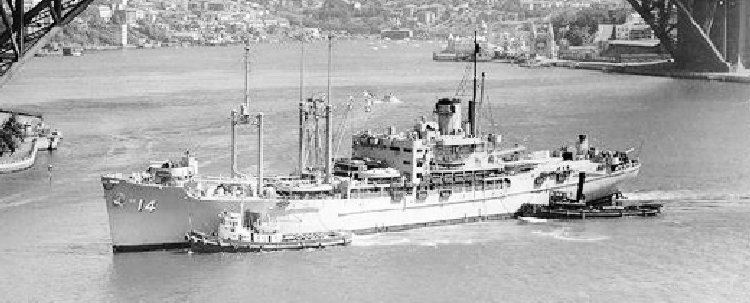 | ||
Namesake Kenneth Whiting (1881-1943), U.S. Navy officer and aviation pioneer Sponsored by Mrs. Edna Andresen Whiting Builder Seattle-Tacoma Shipbuilding Corporation | ||
USS Kenneth Whiting (AV-14) was the lead ship of her class of seaplane tenders in the United States Navy.
Contents
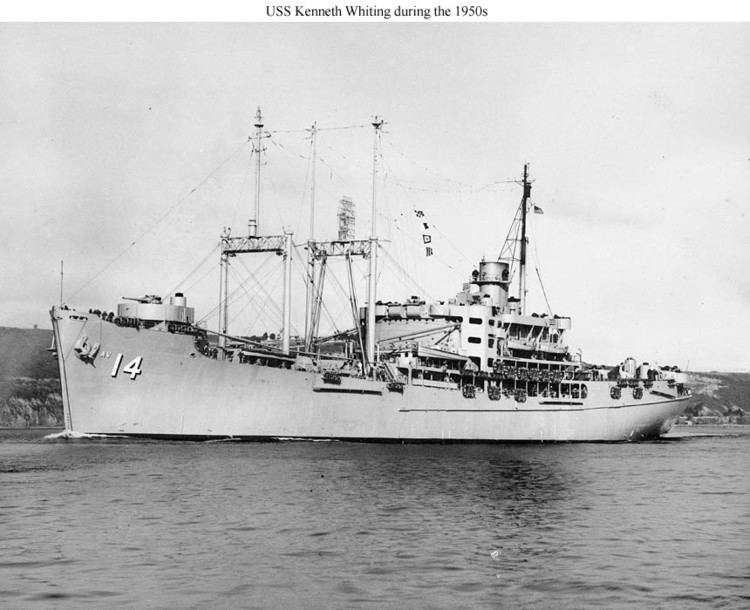
Captain Kenneth Whiting, USN
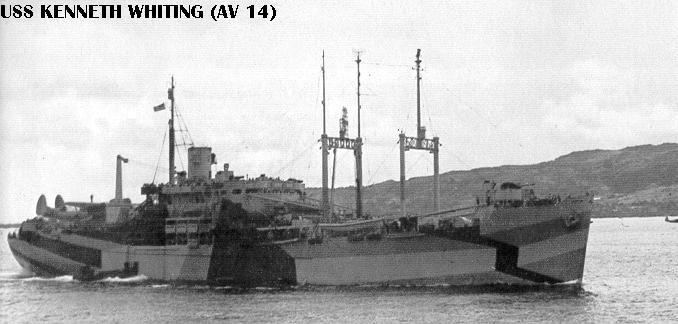
Kenneth Whiting was launched on 15 December 1943 by Seattle-Tacoma Shipbuilding Corporation, Seattle, Washington; sponsored by Mrs. Edna Andresen Whiting, widow of Captain Kenneth Whiting. Kenneth Whiting (Naval Aviator No. 16) received flight training from the Wright brothers at Dayton, Ohio; and was the first executive officer of the first United States aircraft carrier USS Langley (CV-1). Commander Whiting was credited with many basic tenets of naval carrier aviation, including landing signal officers, pilot ready rooms, a darkroom and photo lab to develop movies of carrier landings, and making pilot qualification a requirement for command of an aircraft carrier.
Early Operations
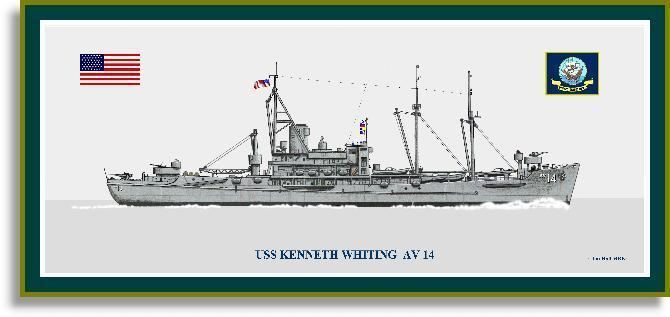
Kenneth Whiting was commissioned 8 May 1944 with Commander R. R. Lyons in command. After shakedown along the West Coast, Kenneth Whiting cleared San Diego on 21 July 1944 and arrived Saipan on 14 August for operations in the Marianas. Her PB2Y squadron made reconnaissance flights which provided valuable data necessary to the success of the Allied operations. At Tanapag Harbor, Saipan, Kenneth Whiting used a former Japanese seaplane ramp to augment the maintenance facilities and increase the availability of planes. She sailed for Kossol Passage on 20 November, relieving the tender Pocomoke (AV-9) there three days later. She remained in the Palau Islands until 5 February 1945.
Okinawa
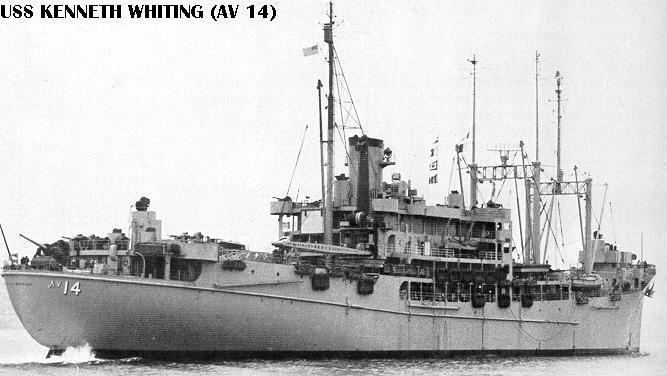
Arriving Ulithi on 6 February, Kenneth Whiting resumed tending seaplanes. On 11 March while she was still off Ulithi, two enemy suicide planes attacked the base. One crashed into Sorlen Island; but the second dove into the aircraft carrier Randolph (CV-15). The seaplane tender cleared Ulithi on 2 April; received provisions and supplies at Guam and Saipan; then steamed to Okinawa, arriving 25 April and immediately commencing combat and search operations. On 11 May her lookout sighted a group of 29 Koreans waving a white flag on the beach of Gerum Shima. An armed boat party from the tender took them into custody for transfer to the POW camp on Zamami Shima. While at Okinawa Kenneth Whiting operated as fleet post office and a housing center for aircraft survivors.
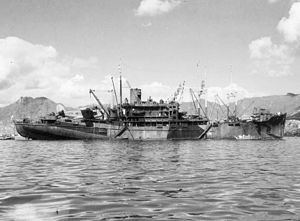
At 1830, 21 June, five hours after Major General Roy Geiger had declared Okinawa secured, a small group of kamikazes penetrated Kerama Retto. Kenneth Whiting knocked down a Ki-43 "Oscar" but part of the plane hit her, causing minor damage and wounding five men. However, she continued operations out of Okinawa for the rest of the war. During July her planes flew armed reconnaissance along the coasts of Japan, Korea, and China locating targets for 3rd Fleet raids.

Kenneth Whiting departed Okinawa on 19 September and anchored at Sasebo two days later. The tender was then assigned to China duty, arriving Hong Kong on 14 October. Her patrol bombing (VPB) squadron commenced patrol courier service, and continued this until she was relieved 28 November. She arrived San Francisco on 22 December with 572 Navy officers scheduled for release. With the close of the war and the emergence of the Atomic Age, Kenneth Whiting cleared San Diego on 6 May 1946 to operate with support forces during atomic tests at Bikini. She returned to San Diego 30 August; transferred to San Pedro 30 October; and decommissioned there on 29 May 1947.
Cold War Service
Kenneth Whiting recommissioned at San Diego on 24 October 1951, and sailed for Far Eastern duty 13 March 1952. She arrived Yokosuka, Japan, on 29 March where she became the Flagship of the Commander, Taiwan Patrol Force (CTF 72) visiting Iwakuni, Okinawa, Taiwan, Subic Bay, and Hong Kong regularly until 16 October when she sailed for the United States.
Following overhaul at Bremerton, Washington, and coastal operations out of San Diego, Kenneth Whiting sailed on 2 March 1953 for another WestPac deployment, supporting seaplane activities out of Japan in the final months of the Korean War.
After the war, Kenneth Whiting made annual deployments to the Far East in support of the 7th Fleet activities. During the summer of 1955, she operated in the Formosa-Pescadores area in the wake of repeated Communist harassment on Chinese Nationalist-held islands. On 29 March 1957 she arrived at her new home port Crescent Harbor, Washington, but sailed for another Far Eastern tour on 12 August. She continued operations with the 7th Fleet until 31 January 1958 when she cleared Subic Bay, Philippines, and returned to Crescent Harbor, 10 March. Kenneth Whiting decommissioned at Puget Sound 30 September, and was struck from the Navy List on 1 July 1961, and sold on 21 February 1962 to Union Minerals & Alloy Corp.
Kenneth Whiting received two battle stars for World War II.
